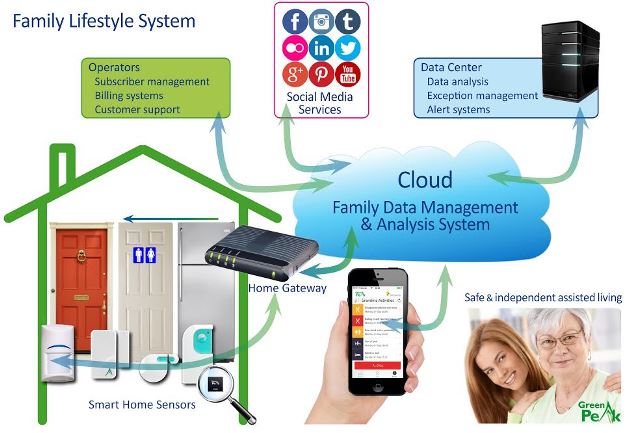Device
Web Connection
What do IoT and smart home device makers need to know
in order to connect their devices to the web.
Cees Links,
CEO,
GreenPeak Technologies
|
March 2016 |
[an error occurred while processing this directive] |
|
Device
Web Connection |
Cees Links, CEO, GreenPeak Technologies |
| Articles |
| Interviews |
| Releases |
| New Products |
| Reviews |
| [an error occurred while processing this directive] |
| Editorial |
| Events |
| Sponsors |
| Site Search |
| Newsletters |
| [an error occurred while processing this directive] |
| Archives |
| Past Issues |
| Home |
| Editors |
| eDucation |
| [an error occurred while processing this directive] |
| Training |
| Links |
| Software |
| Subscribe |
| [an error occurred while processing this directive] |
Worldwide,
thousands of technology companies are viewing the Internet
of Things and the Smart Home as the Holy Grail for their products and
profits. Most industry analysts and leaders are predicting that
hundreds of millions of homes will want these new technologies.
However, before the device makers begin to design and develop new
solutions, they need to understand that this market is rapidly changing
and evolving, especially when looking at the Smart Home and the
consumer electronics market. This is a moving target that manufacturers
need to understand.
First off, the Internet of Things – especially for the Smart Home, is
not about things, but instead, is about services that will make
consumers’ lives more comfortable, more secure and more efficient.
Energy control, security, improving the efficiency of daily life, etc.
Unfortunately, the label of the IoT with the word “things” puts many
people on the wrong path of thinking.
Things are the necessary enablers, but the complete solution includes
data analytics, smart phone apps and billing/support systems as well.
There is an entire ecosystem at play, in which things play a minor role.
Also, many people confuse IoT things with connected devices. It is not
enough to just web connect a device – it needs to be able to speak to
other devices and systems in the home, as well as to be able to become
smart – to utilize web intelligence, so that it is more than just a
remotely operated sensor or actuator.
If a manufacturer wants to be successful in the new and highly
competitive Internet of Things market, it needs to understand two
important concepts:
Manufacturers and service providers need to work
together – to bring
all the different home equipment and services together under a single
umbrella with a common UI – a single app (I.E. a Smart Home Butler)
that lets the family members understand what is happening in their home
and enables them to manage it, if not managing it for them.

The Family
Lifestyle system uses sensors,
connected devices, cloud intelligence, and social media to combine a
variety of important services into a simple to use app that enables
service providers to make their customer’s lives easier and more secure.
[an error occurred while processing this directive]
The Smart Home is a
wonderful concept, but concepts alone do not solve
immediate customer needs. For example, no one is looking for a
refrigerator that can talk with the toaster – but if these kinds of
kitchen appliances can help make the home shopping task simpler, if the
connected appliances can make it easier to schedule and prepare meals,
then maybe this really is an effective solution that people are
interested in. Device makers need to be very precise in what problem
they are solving for their customer, and evolve away from simply
marketing the “concept” of connected devices.
The end game is connected solutions that make our lives easier, safer
and more efficient. Device makers and service providers need to look at
the BIG picture, not just the components and the individual machines
and devices.
About the Author
Cees Links, CEO and Founder of GreenPeak
Cees Links is the founder
and CEO of GreenPeak. Under his responsibility, the first wireless LANs
were developed, ultimately becoming household technology integrated
into PCs and notebooks. He also pioneered the development of access
points, home networking routers, and hotspot base-stations. He was
involved in the establishment of the IEEE 802.11 standardization
committee and the Wi-Fi Alliance. And, he was instrumental in
establishing the IEEE 802.15 standardization committee to become the
basis for the ZigBee sense and control networking.
GreenPeak Technologies is a fabless semiconductor company and is a
leader in IEEE 802.15.4/ZigBee silicon solutions for the Smart Home and
the Internet of Things. GreenPeak is privately funded. It is
headquartered in Utrecht, The Netherlands and has offices in the United
States, Belgium, Japan, China, France, India and Korea. GreenPeak has
won the prestigious 2014 Deloitte Fast50 Award and is recognized as a
leader in developing new wireless technologies for consumer electronics
and Smart Home applications, demonstrating rapid growth and adoption by
major customers.
For more information, please visit www.greenpeak.com
[an error occurred while processing this directive]
[Click Banner To Learn More]
[Home Page] [The Automator] [About] [Subscribe ] [Contact Us]